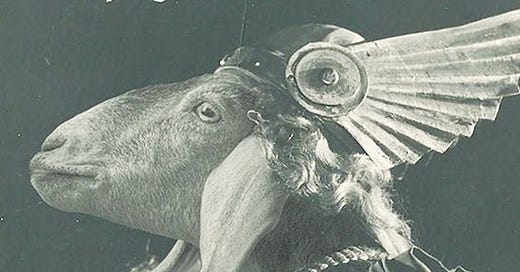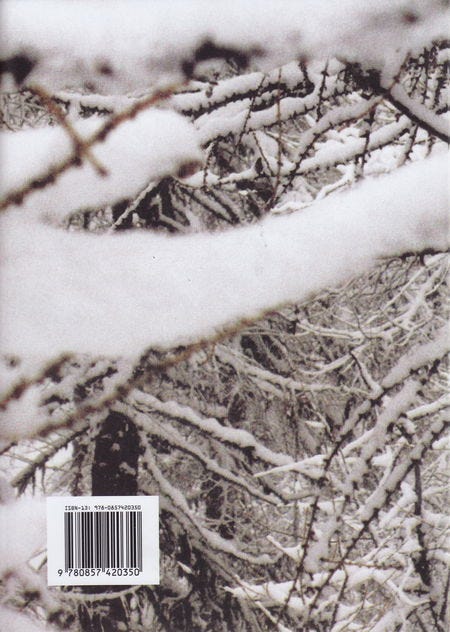Alexander Kluge: Temple of the Scapegoat—Opera Stories, translated by Isabel Fargo Cole, Donna Stonecipher Nathaniel McBride, Wieland Hoban, Martin Chalmers & Martin Brady. New York: New Directions, 2018.
Alexander Kluge: The Air Raid on Halberstadt on 8 April 1945, translated by Martin Chalmers. Chicago: Seagull Books, 2022 [2008].
Alexander Kluge, Gerhard Richter: December, 39 Stories, 39 Pictures, translated by Martin Chalmers. Chicago: Seagull Books, 2021 [2010].
When you hear the phrase New German Cinema — Das Neue Kino — you wouldn’t be faulted for thinking of Werner Herzog, Wim Wenders, and Rainer Werner Fassbinder. Their films have been proliferating since the 60s.
Lesser known, however, is the man who was the movement’s ideological leader, Alexander Kluge. Kluge started out as an assistant to Fritz Lang, and joined the post-’68 wave of challenging and politically charged movies. He also published scholarship with the sociologist Oskar Negt, which has made him a necessary point of reference in the field of postwar aesthetics and critical theory.
Far more prolific than his cinematic output is Kluge’s writings. He’s accumulated a mountain of books full of short prose pieces since the 70s. And superficially, these books are not too different from his montage-fueled movies; they include factual evidence as well as science-fiction scenarios, diagrams, photographs, illustrations, pedagogical time-out boxes…
That all sounds tantalizing. Even more so because of Kluge’s ambitions or pretensions toward Marxist aesthetics — including realizing Eisenstein’s dream project of a cinematic adaptation of both Joyce’s Ulysses and Marx’s Capital (see the link below the dividing line).
The first difficulty with Kluge for your host was that, in English, the prose is quite dry. A more limpid style might have helped carry the reader along this mass of fragments, but instead we’re constantly reframing through what feel like fictitious encyclopedia entries. Kluge was a student of Adorno, and this ultra-plain prose may reflect the rationalization that the Frankfurt School thinker held as characteristic of modernism.
The second difficulty with these books was how they are clearly tied to Kluge’s other books as well as his cinema. Opera motifs abound in his films. One story in Temple of the Scapegoat is reprinted verbatim in Air Raid. Some entries are prose adaptations of pre-existing media pieces. It feels like one is sifting through these pieces without context, as the only way to access a heaping intellectual cosmos.
One entry (that my weak research couldn’t confirm if it’s fact or fiction) involves the rehearsal of Beethoven’s Fidelio at the Paris Opera just as the Germans invaded.
Jean-Luc Godard heard this story in 1968. He always had a surprise up his sleeve. At the same time, he was laboring under a certain influence: his brain was anesthetized by the value abstraction of the revolutionary process unfolding in Paris in May 1968. Nonetheless, a man like Jean-Luc Godard can’t be influenced completely, even when a large part of his brain stops working. In dinosaurs the pelvic brain remains intact even when the brain-brain fails…
The selection of details, and the stylistic textures with the all-caps keywords, like some technical manual — these techniques by Kluge add up to an admittedly disarming and bewildering effect on your host.
One fragment headed “The Contrat Social of Families” read like a wild intellectual invention of sociology, with notions of productive payback from children to parents in primordial society, and a “reserve army” of grandmothers, finishing with the economist Ho Wang-Shu arguing
…that the difficulties of actually implementing socialism lie in the fact that it in no way represents a future goal — in fact, modern (and even industrial!) societies actually evolved out of the crumbling of the PRIMITIVE COOPERATION that defined the sensational career of early humans. That means, the comrade pursued, the works of Marx must be rewritten. The EXCHANGE SOCIETY was derived not from PRIMITIVE ACCUMULATION and the concept of the commodity, but from PRIMITIVE FAMILIAL CONTRACTS, as one easily learns, according to Ho Wang-Shu, from looking at EARLY CHINESE HISTORY.
More easygoing are the historical anecdotes that pepper these books. The Preface to Temple caps off with a story from the end of WWI, when the Turks were pushing back the Greeks, then invaded and controlled Smyrna. “Captivated by the Bellini opera” that played in the city’s opera house that night, “they neglected to give the command to burn down the entire city. One southwestern district was spared. This was where the brewery belonging to my grandmother’s brother stood. He personally regarded the opera as superfluous. But Herbert Hausdorf’s property and life were saved by opera’s power to distract even barbarians.”
The Air Raid on Halberstadt on 8 April 1945 is the closest of these three books in resembling a hard non-fiction text, if you couldn’t tell from the specificity of the title.
These pieces render this single Allied bomb run that nearly razed Halberstadt, not a military target, to the ground. Not just from the perspective of the people on the ground, but also the professional armed forces doing the bombing.
Like an agitational pamphlet, the book is swarming with details about the whole strategic doctrine of air marshaling, its sources in the RAF in WWI, now executed by Americans, and what it’s like to be airborne with these bombers.
They cannot ‘want to have’ something here, are self-sufficient, as far as fuel and material to be dropped is concerned. At most it could be interpreted like this, that they are sucking in the labour power of the engineers in the aircraft plants back home or the oil of Texas or Arabia or that the crews are drawing pay on their private accounts or that the total transaction produces profits for the armaments companies.
A footnote in sans serif text at the bottom of this page reads:
…no classes are fighting each other… Instead, ‘above’ and ‘below’, labour power and relation of production are mingled altogether opaquely. The sky is clear, the singleness of purpose of the formations approaching the target, the tension between the ordinary crew members, usually from the lower classes, and elite commanders, or the whole exhausted situation of those below in the town exposed to the production relation air raid…
Here is one of the stories, reproduced in full:
Cooperative Behavior
After the air raid of 11 February 1943 the charred remains of a man were found in a house in Blaubach. One resident of the house maintained, that they were the remains of her husband. A second woman from the same house declared, her husband had likewise been sitting in this destroyed cellar, probably one was sitting next to the other. These were also the remains of her husband’s body. She too would want to be able to visit a grave. At that the woman who had first returned to the ruined building suggested dividing the remains of the charred man.
An allusion to the wisdom of King Solomon, but also a sarcastic(?) reference to the development of productive forces. Marx is quoted in a caption for a picture of the ruined town after the bombing: “We see how the history of industry and its objective existence, are the open book of man’s powers, human psychology made present and perceptible…”
As far as writer-visual artist collaborative books go, Kluge and Richter’s December was among the least memorable. (Though I really like Richther’s paintings!)
It’s a nice structural idea based on the calendar, a prose piece for every day of the month — the German peasantry used to have reading material just like that. And it opens with another historical anecdote, a near-miss auto incident that might have killed Hitler on the 3rd of December 1941. It includes a footnote with a funny phrase about the “well-tempered stomach.”
I, enclosed in the well-tempered stomach, was almost born without Hitler having a bit of future in front of him. Only another 15-16 inches and the two powerful vehicles would have collided on the icy surface with fatal consequences.
(Kluge was born in 1932.)
Other descriptive pieces give us the gentleness of snow-laden branches, a verbal translation of the pictures taken by Richter, as well as a concise image for Kluge’s own process of accumulating little units of prose.
Seen up-close, the heaped snow on the trees standing on the slopes appears as thick as the branches and twigs themselves. It speaks for the gentleness with which the snow settles that such an accumulation is possible.
This book also included another novella-length binding of microessays called “Calendars are Conservative,” a meditation on the “confessional” nature of organizing calendars, including the conversion in Russia to the Gregorian system after the revolution — pretty interesting, but also underscoring Kluge’s retreat form historical materialism to aestheticism.
As for the pictures taken by the artist Gerhard Richter, they were cool but didn’t seem to do much else besides be there in between Kluge’s pieces. The shots in the first half of the book were preferable: framings of those snowy branches and boughs suspended in the foreground like the brushstrokes of an action painting. The later ones by comparison were more conventional, like an exceptionally drab Christmas album.
Overall, as mixed as my impressions of Kluge’s writings sampled here may sound, I’m impressed by this whole tiny unit approach, and the mixture of reportage and narration proper. I’m haunted by a phrase from an interview he gave in 2003: “I consider what I’m doing the modern form of the novel.”
Fredric Jameson on Kluge’s Notes from Ideological Antiquity.
In last week’s letter in memoriam to FJ, I brought up the “two big seminar books” of Jameson’s that came out this year. The first one, on “German aesthetics”, is Mimesis, Expression, Construction, which concerns Adorno. There are a couple of references to Adorno’s student Kluge in these lectures, bizarrely transcribed verbatim by Octavian Esanu.
As with Kluge, very briefly, I think he is a wonderful filmmaker. Now he makes late-night productions, like he gets ten minutes at three in the morning where he interviews someone, and he puts it on German television… [Quietly: it’s quite a crazy operation.] He is also a wonderful writer, the little collection of stories that you might wanna look at is called, hmm… [Agitated.] Well, we published one of them, which is called Learning Processes with a Deadly Outcome, that was translated by our university press, and here the key novella is the story of the Nazis’ space astronauts on the moon… [Mumbles indistinctly.] It was first published in Germany in 1973, and it is a mixture of fact and fiction and also images, made in this quasi-documentary style that combines science fiction with reportage — very remarkable. He’s also a philosopher, his big book hasn’t been translated and it’s called “History and…” [Raps his knuckles on the desk] something, which is a large book also with pictures and a whole theory of history.
(That “big book,” History and Obstinacy, would not come out in English for another decade after this course was held.)
Earlier in the lecture series, one of the seminar students giving a presentation on Adorno’s film writings had this to say:
In his thoughts on montage, Adorno was clearly influenced by the German author, philosopher, academic and film director Alexander Kluge, for whom literary discourse is at the center of his literary practice… [Quietly: we don’t have any of his books here in the library.] In his montage theory, Kluge emphasized the “empty spaces between shots (Leerstellen)” as the sites of resistance to the power of the image… [Quietly: in this, Kluge is different from Eisenstein’s theory of montage that prioritizes the image.] He argues that only [sic] within these empty spaces that the imagination of the spectator is activated, as meaning does not reside in the film but in the spectator.



